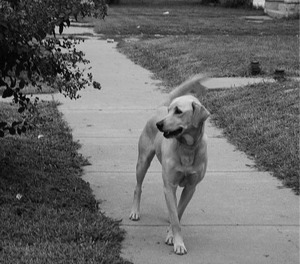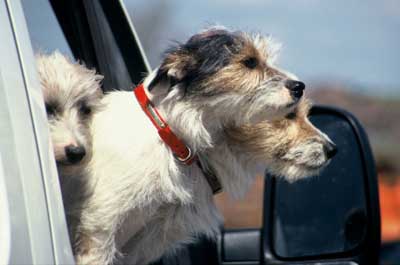Lowering the ‘Boom’: Reducing Pets’ Noise Sensitivities
When summer thunderstorms roll in, some pets dive for cover. If your dog or cat is among those terrified by storms or other sudden, loud noises, such as fireworks, there are steps you can take to help reduce your pet’s anxiety.
According to Dr. Kelly Ballantyne, a veterinarian with a special interest in animal behavior, the reason pets are scared of thunderstorms isn’t always clear. One study found that a traumatic experience linked to noise was the likely origin of noise sensitivity in only about a third of pets with these phobias. Other factors that may contribute to noise sensitivities include chronic stress, genetics, neurochemical imbalances, and a change in hearing.
Practicing at the University of Illinois Chicago Center for Veterinary Medicine, Dr. Ballantyne offers behavior consultations to help pets with phobias and other behavioral issues.
She says it is perfectly normal for a pet to be scared by the loud noises and flashes the first time the pet experiences a thunderstorm or fireworks. A pet may react defensively to these high-decibel noises because they probably hurt the pet’s ears, they lack a regular pattern, and it’s difficult to figure out where they are coming from.
It isn’t normal, however, if the animal does not get used to storms, and each thunderstorm is as terrifying as the previous one. Unfortunately, thunderstorms are common, and these frequent stressors can reduce a pet’s quality of life. Addressing your pet’s fears is important for the sake of the pet—not to mention the household objects sometimes destroyed by frightened pets.
Dr. Ballantyne suggests several measures that may help noise-sensitive pets feel a little safer and less frightened during a thunderstorm.
“First, try to make a safe place where your pet can go,” she says. “An interior room with no windows is ideal because it is more sheltered from noise and the flashes of light. Avoid crating your pet unless the pet already feels that the crate is a safe place.”
When pets are already hiding, don’t force them out: that can scare and stress them more. Playing music or increasing the white noise in the house can decrease the perceived amount of noise from the storm.
Your behavior around your pet also plays an important role in managing the pet’s anxiety during a storm. You should avoid either comforting or punishing the pet, and you should stay calm to avoid increasing the pet’s anxiety.
If your dog isn’t too scared, you can try to play with him. Interactive toys, such as a Kong filled with food, can help as well if he is willing to eat.
A pheromone spray for dogs called DAP helps reduce anxiety in some dogs. It can be sprayed on a bandana and tied around the pet’s neck during a storm.
Dr. Ballantyne acknowledges that noise sensitivities can be hard for owners to manage. Sometimes you can do everything right and your pet is still scared of the storms.
“Don’t hesitate to ask your veterinarian for help,” advises Dr. Ballantyne. “If nothing else is working, your veterinarian can prescribe anti-anxiety medication to augment the behavior modification plan.”
Don’t forget that a pet that is scared of thunderstorms will likely have a similar reaction to fireworks. These pets should be given a safe place to hide during the celebration and should never be taken to watch fireworks.
If you have questions about pets’ noise sensitivities, please contact your veterinarian or a veterinary behaviorist.
Andrea Lin is an Information Specialist at The University of Illinois at Urbana-Champaign College of Veterinary Medicine.
Cyberpets: Microchips Help Lost Pets Find Their Way Home
Keeping your pets safe and sound has become a huge industry, from GPS trackers for your pet’s collar to invisible fences designed to keep them where they’re supposed to be. But even the most diligent pet owners can sometimes find themselves faced with a dog or cat that’s managed to go AWOL. In those heart-wrenching situations, a microchip can make the difference between hours, days, or weeks of fruitless searching and a quick reunion with your beloved animal.
If you’ve bought or adopted a pet within the last few years, you’ve probably heard of microchipping. It’s a process that has largely become standard procedure in most adoption centers and vet clinics, frequently included with the standard new pet services like vaccinations and spaying or neutering. Despite the high-tech name, we’re not actually talking about turning your puppy into a robot. Microchipping is actually a very simple procedure.
Preparing our robot puppy overlords

A microchip implant is a tiny, integrated circuit placed under the skin of a dog, cat, or other animal. Using passive RFID technology, it contains an identification number that is linked to a database. Pet owners can register their pet’s microchip through various websites so that if the animal is ever lost or stolen and then found, a shelter or veterinarian can return the animal where it belongs.
The chip itself is just a tiny bit bigger than a grain of rice, and it can be implanted without anesthesia in just a few minutes at a vet’s office. It doesn’t hurt the animal at all, and once it’s in place, neither you nor your pet will even know it’s there.
Standards and information
When pet microchips first became available, every company that made a chip used its own database and its own radio frequency, requiring a proprietary scanner to read. This proved to be a huge issue for shelters and clinics, which needed multiple scanners in order to check the animals that came in.

Thankfully, most manufacturers now follow the International Standards Organization (ISO) guidelines for animal microchips so that any chip created following those guidelines can be read by any scanner. The United States doesn’t require that animals be tagged with an ISO-compliant chip, but several other countries do. In the United States, vets and shelters must rely on scanners that can read the ISO chips and the four major types of proprietary chips available today.
Show me some identification
The chip itself isn’t like a driver’s license, containing a lot of identifying information, nor is it a GPS location device. The only information the chip contains is a unique identification number and sometimes the phone number or website for the registry of the company that produced the chip.

It’s up to you, the pet owner, to make sure that you register the chip and keep your information up to date. The vet, shelter, or adoption agency where you acquired your pet should provide you with the instructions for setting this up initially. If you move or change phone numbers, make sure you update the chip registry!
Beam me home, Scotty
A study cited by the American Veterinary Medicine Association points out that lost dogs and cats with microchips are successfully returned to their owners 52.2% and 38.5% of the time, respectively, versus just 21.9% and 1.8% for dogs and cats without microchips. Even pets that have traveled thousands of miles have still been reunited with their owners, thanks to microchips.
One piece in the responsible pet owner puzzle

Being a responsible pet owner is an ongoing process. Your furry companion needs regular veterinary care, and it’s a great idea to ask your vet to scan your pet’s microchip whenever Fluffy’s in for a checkup just to make sure it’s still in working order.
While the microchip technology is very well tested, it’s not completely foolproof. Make sure that your dog or cat is wearing a collar and tags at all times, including at least one tag with a phone number where you can be reached. If Fido wanders down the road and is picked up by a good Samaritan, it’s much easier for that person to call the number on his tag than figure out how to get him to a vet to read the microchip.
The heartache and angst of losing a pet can be devastating, but planning and diligence — and a little dose of technology — will give your beloved companion a much greater chance of finding his way home!
This story first appeared on Tecca. More from Tecca:
Fat Fido’s Best Friend: An $8,000 stair lift for pets
Put a leash on your pet’s vet care schedule
Review: Find your pet wherever it may roam using Tagg Pet Tracker
Resolve to Keep Your Pet at a Healthy Weight
Weight loss ranks high on the list of New Year’s resolutions. But while people may recognize that their clothing has become too snug and they should reduce, pet owners often have a hard time seeing that their pet’s girth has also expanded unacceptably.
Pet obesity is a growing problem that often isn’t taken seriously, even though it contributes to life-threatening and life-shortening conditions such as cancer, heart disease, joint problems, and more.
Kim Knap, a certified veterinary technician and a certified canine rehabilitation practitioner, runs the Companion Animal Rehabilitation clinic at the University of Illinois Veterinary Teaching Hospital in Urbana. Through a program called “Shape up, Pup!” Knap works with pet owners to develop practical, individualized plans to safely achieve and maintain ideal body weight for pets.
If you are uncertain whether your pet may have a weight problem, Knap offers these guidelines: “You should be able to easily feel the ribs without a layer of fat. When you look down at your pet, you should be able to see a waist, and when you look from the side, you should see a tucked abdomen,” she says.
But what if Fluffy is, well, fluffy?
“For pets with lots of fur, run your hands through the fur to see if you can easily feel her ribs,” says Knap.
If you think your pet’s weight may be a problem, call this to the attention of your veterinarian. If the veterinarian rules out metabolic disorders, you may be referred to a rehab program like “Shape up, Pup!” that would create a personalized plan to fit you and your pet. These programs often have special equipment, such as a doggy treadmill, that will make exercise more fun for your pet. You will find plenty of options and people who can help once you start looking.
Knap cautions that unmonitored treats are a common pitfall in an otherwise well-regulated pet diet.
“Commercial treats are typically high in calories,” says Knap, “and the semi-moist variety is especially bad. Moist treats add fats and sugars to keep them moist.”
What should you do if your pet habitually looks at you with big sad eyes and begs for treats? Knap says he may really just be begging for your attention and playtime. Try finding more time to play, she advises, which provides both the attention he craves and the activity he needs.
Another approach Knap recommends is to replace calorie-laden treats with baby carrots or ice cubes, inexpensive choices that your pet will love. Most dogs will be just as thrilled about getting that carrot piece and your attention as getting a processed commercial treat. And you might enjoy watching your pet dash after the slippery ice cube just as much as your pet likes chasing it.
Keeping pets at an ideal weight helps them live longer, healthier lives. Fit pets can make the most of play time without tuckering out early, and they are less likely to develop chronic, life-threatening diseases.
For more information about your pet’s ideal weight, talk to your local veterinarian.
Andrea Lin is an Information Specialist at University of Illinois’ College of Veterinary Medicine.
Pet Travel for Happy Tails
Looking forward to a much-needed vacation but not sure about leaving your furry friend behind? We’ve got some advice from the experts on the best ways to travel with your whole family in tow.
Plan Ahead
Not all hotels allow pets inside, so before you leave, research hotels near your stops and make reservations at places you know you can take pets. That way, you know your pet will be welcomed wherever you go. Some hotels even have special VIP accommodations for visitors with pets.
Pet owners should “stay at a place that will respect and welcome them,” says Dan Douglas, the general manager of a Best Western in Allen Park, Michigan.
“We’ve had so many great experiences with pets and pet owners,” Douglas adds. “Problems are rare and far between.”
It’s also a good idea to look into restaurants and activities in the places you’re visiting. Be sure to choose pet-friendly places to go. If not every place on your agenda allows pets, make sure you have the appropriate equipment to leave your pet in the hotel for a couple hours. Notify the front desk and put a “Do Not Disturb” sign on the door so the cleaning service doesn’t come in while you’re gone.
You should also check to make sure there are vets in the area you’re visiting. “Like people, pets on vacation do things they wouldn’t normally do,” says Dr. Meryl Kardon of Back Bay Veterinary Clinic in Boston. Owners should know where to go in case their pet has a medical emergency.
Visit Your Vet
Bring your pet in for a checkup. Make sure he or she is up to date on vaccinations. Some states require you to present rabies vaccination confirmation before you cross the border, so you need to get that from your vet and keep it handy. Many airlines require a certificate of health from within 10 days of the flight. This also applies to a return flight. If you’re going somewhere for more than 10 days, Dr. Sara Rudwell of the Broad Ripple Animal Clinic in Indianapolis, Indiana, recommends that you find a vet in the area you’re staying to do a pre-flight checkup.
You should also talk to your veterinarian about medications or anything else your pet might need to stay comfortable and healthy on the trip. Don’t try any medications or sedatives without your vet’s approval, since they could cause problems or bad reactions, particularly while you’re in the air.
“They could have trouble breathing, or their blood pressure might be dropping,” says Dr. Julie Moodoyan of Southwood Animal Hospital in Tallahassee, Florida. “Particularly on an airplane, it’s hard for pets to be monitored.” In fact, she says many airlines won’t allow a visibly sedated animal onto the plane.
Get Your Pet Acclimated
Make sure your pet is used to traveling before you set out on a long journey. If you’re driving in a car, take smaller trips around your hometown to give your pet practice with being in the car.
If you’re using a kennel, carrier, cage, or crate to transport your pet, either in a car or an airplane, have your pet spend some time in it at home. The kennel will need to be big enough for your pet to sit, stand, and turn around.
Stranger Safety
If you need to transport your pet and don’t want to do it yourself, there are several service options available, depending on your location. However, make sure to do plenty of research on any company you want to hire. Many pet transportation services have been accused of harming or even killing pets in their care due to neglect or abuse. Make sure you have thorough information—some companies have even been known to fake recommendations to get people to hire them.
“On the whole, it’s not the greatest idea,” says Dr. Kardon, though she adds that most pet transporters are very hard and good workers. “Check into the number of pets being transported and the crowding situation.”
It’s always best to check with your vet and others you know and trust who might have experience with pet transportation services to make sure you hire a good company.
Safety First
While you’re traveling, one of your main concerns should be making sure your pet is safe and secure. Always keep your pet in a kennel or strapped into a seatbelt. And even though dogs love sticking their heads out the window or sitting in the back of a pick-up truck, both are dangerous and result in a high death toll for dogs.
Never leave your pet unattended in a car. Not only is there a risk of pet-napping, but pets left in cars can overheat or freeze, depending on the weather. This can also be the case while you’re on the road. If you’re too hot or cold, then your pet probably is, too.
Staying Comfortable
Pets require more than a good kennel to travel comfortably. Be sure to supply your pet with a couple of familiar toys to make the journey more enjoyable. Keep plenty of water handy so your pet doesn’t get dehydrated in the car. It’s always wise to bring your own from home, since your pet might react badly to strange water.
Also, don’t feed your pet too much right before you start out or while the car is in motion. Your pet could get carsick, and that’s not comfortable for him or for you.
Dr. Moodoyan recommends that you bring several familiar toys and blankets for your pet. She says pheromone sprays can also help make your pet feel at ease.
“They utilize the pet’s own pheromones and decease the pet’s anxiety,” she says. She adds that the sprays are odorless to humans. You can find a spray at most pet stores and vet offices.
Pets on a Plane
Today, many airlines allow cats and smaller dogs to travel with you instead of in the cargo hold, which is more comfortable for both of you. Whether or not this is the case, it’s always best to book a nonstop flight to your destination rather than dealing with tricky layovers and plane changes.
Be sure to make reservations in advance so your pet gets a spot on the plane, since some airlines have limits on how many and what kind of pets can travel. “Pets traveling in the cabin require a reservation to ensure no more than seven pets are booked on any single flight,” according to American Airlines.
Make sure that you follow the airline’s regulations about kennel size and vet checkups, particularly since your pet might have trouble adjusting to cabin pressure. Before you leave, “Ask the airline appropriate questions,” says Dr. Rudwell. She advises double-checking on the airline’s pet policies as well as checking the weather to make sure your pet won’t be too hot or cold during the flight.
To make things as easy as possible, walk your pet outside the airport before you take off, and make arrangements to register near the time of departure, so your pet doesn’t spend hours sitting at the airport. In case of an accident while in the air, place absorbent puppy pads or towels in the kennel.
Keeping Track of Your Pet

While you’re traveling, there’s always a chance that your pet could get lost or stolen. Keep him in a collar with your name, address, and phone number.
Many pet institutions are recommending that you have a microchip installed before you leave. These small chips can be read by pet hospitals, vets, and shelters across the country. They make it easy to get information on your lost pet and return him to you quickly.
The microchips, which are about the size of a grain of rice, can be “easily implanted under a pet’s skin,” says Dr. Moodoyan. “Any vet’s office can do it.
“I always recommend a microchip and collar,” she adds.
The procedure is safe and inexpensive, so talk to your vet about it before you leave.
For more information on the tips above, see the links below:
http://hyperboleandahalf.blogspot.com/2010/05/sneaky-hate-spiral.html
http://www.bestwestern.com/tripplanner/travelwithpetstips.asp
http://www.aspca.org/pet-care/pet-care-tips/car-travel-tips.html
http://www.petswelcome.com/
http://www.koa.com/familyzone/camping101/pets10tips.htm
http://www.southwoodanimalhospital.com/